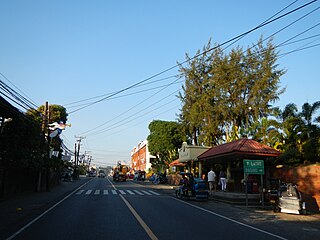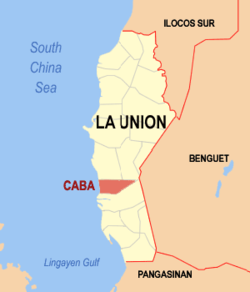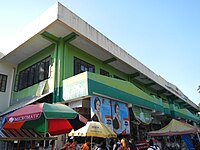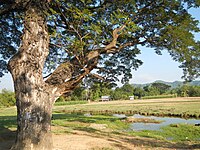
Ilocos Region is an administrative region of the Philippines, designated as Region I, occupying the northwestern section of Luzon and part of Central Luzon plain, primarily by Pangasinan. It is bordered by the Cordillera Administrative Region to the east, the Cagayan Valley to the northeast and southeast, and the Central Luzon to the south. To the west lies the South China Sea.

Aringay , officially the Municipality of Aringay, is a second class municipality in the province of La Union, Philippines. According to the 2020 census, it has a population of 50,380 people.

San Fernando City, officially the City of San Fernando, is a 3rd class component city and capital of the province of La Union, Philippines. According to the 2020 census, it has a population of 125,640 people.

Bauang, officially the Municipality of Bauang, is a 1st class municipality in the province of La Union, Philippines. According to the 2020 census, it has a population of 78,449 people. In Philippine Literature and History, it is known for being the homeplace of literary icon and World War II martyr Manuel Arguilla.

Paoay, officially the Municipality of Paoay, is a 4th class municipality in the province of Ilocos Norte, Philippines. According to the 2020 census, it has a population of 25,001 people.

Piddig, officially the Municipality of Piddig is a 3rd class municipality in the province of Ilocos Norte, Philippines. According to the 2020 census, it has a population of 22,475 people.

Solsona, officially the Municipality of Solsona, is a 3rd class municipality in the province of Ilocos Norte, Philippines. According to the 2020 census, it has a population of 24,851 people.

Sarrat, officially the Municipality of Sarrat, is a 4th class municipality in the province of Ilocos Norte, Philippines. According to the 2020 census, it has a population of 25,186 people.

Cabugao, officially the Municipality of Cabugao, is a 1st class municipality in the province of Ilocos Sur, Philippines. According to the 2020 census, it has a population of 38,884 people.

San Ildefonso, officially the Municipality of San Ildefonso, is a 5th class municipality in the province of Ilocos Sur, Philippines. According to the 2020 census, it has a population of 8,190 people.

Santa, officially the Municipality of Santa, is a 4th class municipality in the province of Ilocos Sur, Philippines. According to the 2020 census, it has a population of 14,992 people.

Agoo, officially the Municipality of Agoo, is a 1st class municipality in the province of La Union, Philippines. According to the 2020 census, it has a population of 66,028 people.

Balaoan, officially the Municipality of Balaoan, is a 1st class municipality in the province of La Union, Philippines. According to the 2020 census, it has a population of 40,339.

Luna, officially the Municipality of Luna, is a 3rd class municipality in the province of La Union, Philippines. According to the 2020 census, it has a population of 37,318 people.

Pugo, officially the Municipality of Pugo, is a 5th class municipality in the province of La Union, Philippines. According to the 2020 census, it has a population of 19,337 people.

Rosario, officially the Municipality of Rosario, is a 1st class municipality in the province of La Union, Philippines. According to the 2020 census, it has a population of 60,278 people.

San Guillermo, officially the Municipality of San Guillermo, is a 4th class municipality in the province of Isabela, Philippines. According to the 2020 census, it has a population of 20,915 people.

San Felipe, officially the Municipality of San Felipe, is a 4th class municipality in the province of Zambales, Philippines. According to the 2020 census, it has a population of 25,033 people.

Guinayangan, officially the Municipality of Guinayangan, is a 3rd class municipality in the province of Quezon, Philippines. According to the 2020 census, it has a population of 44,045 people.
The legislative districts of La Union are the representations of the province of La Union in the various national legislatures of the Philippines. The province is currently represented in the lower house of the Congress of the Philippines through its first and second congressional districts.


































